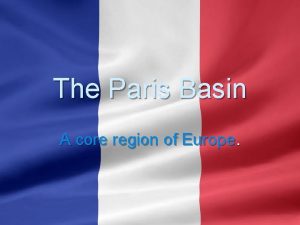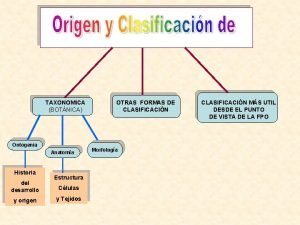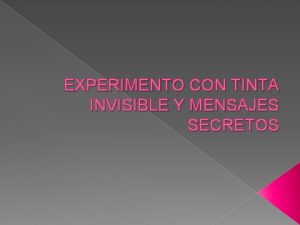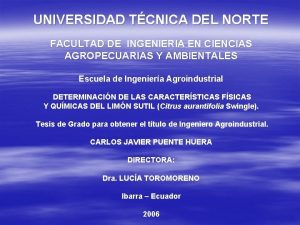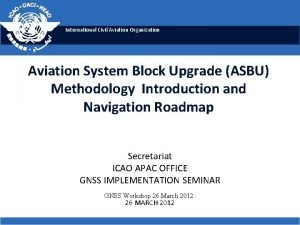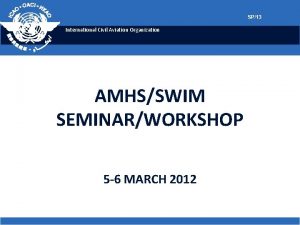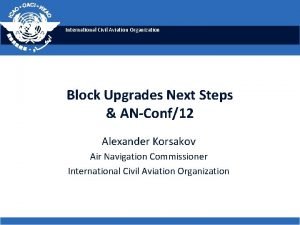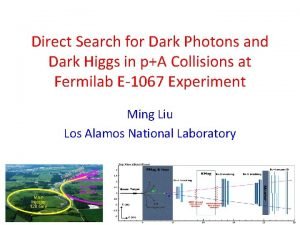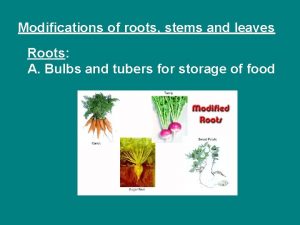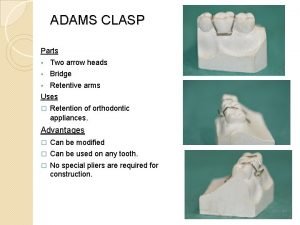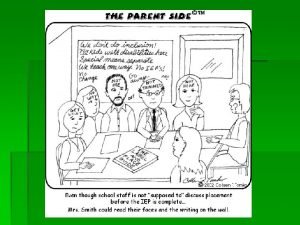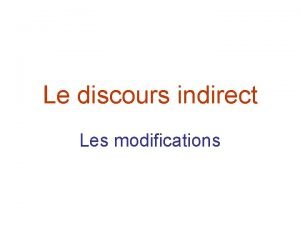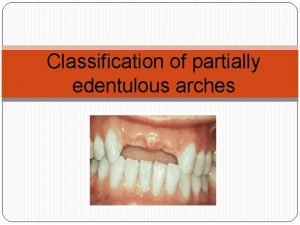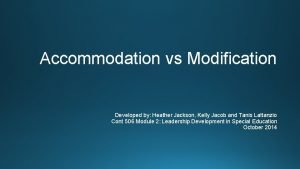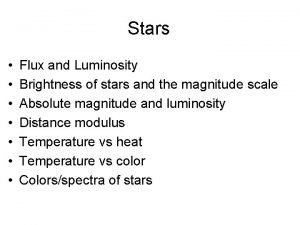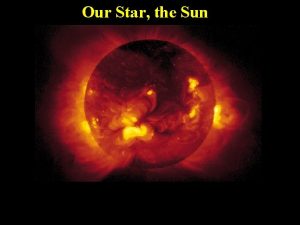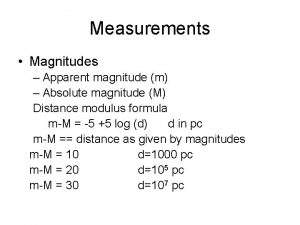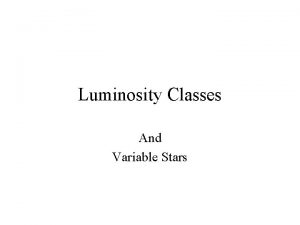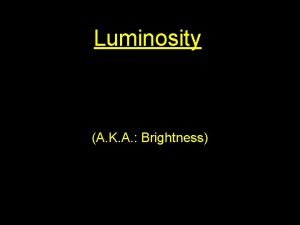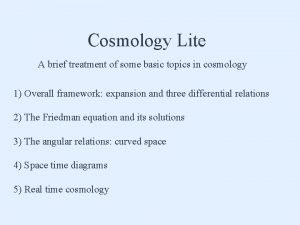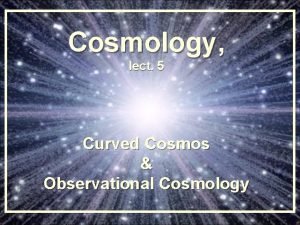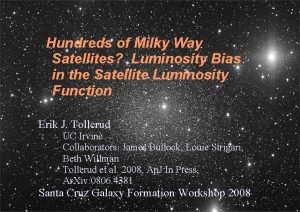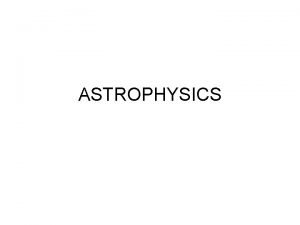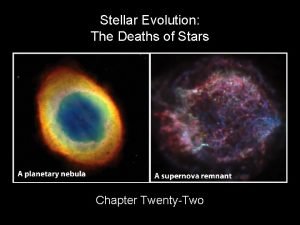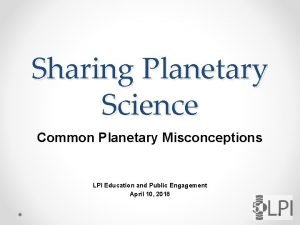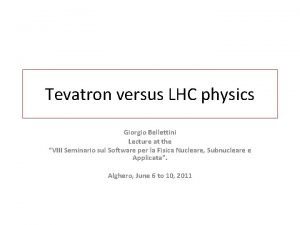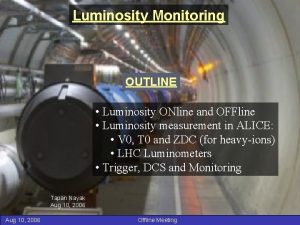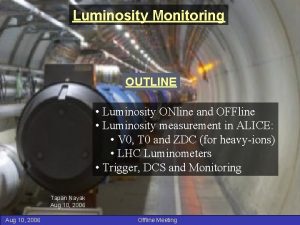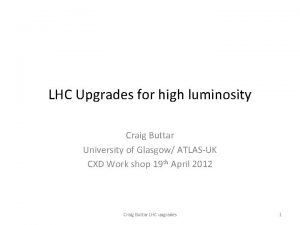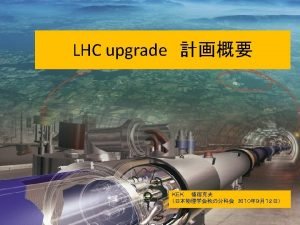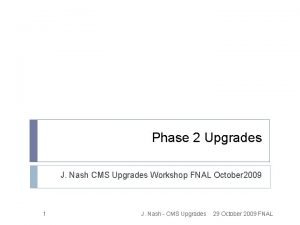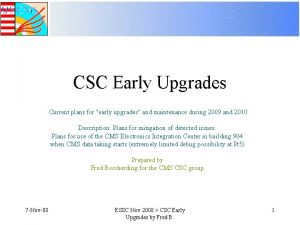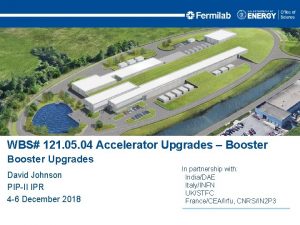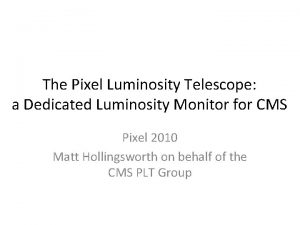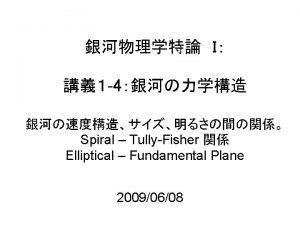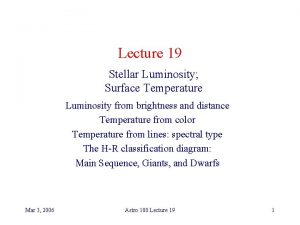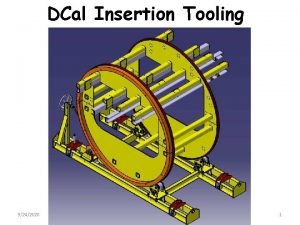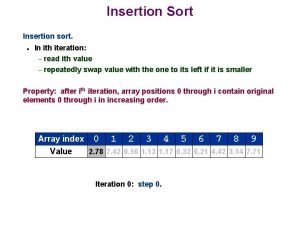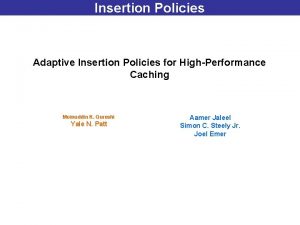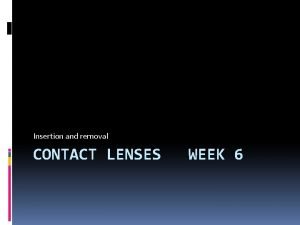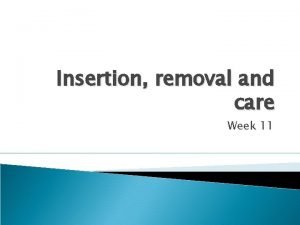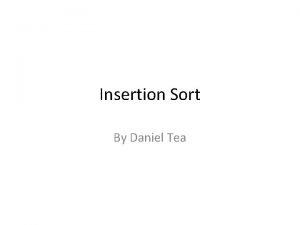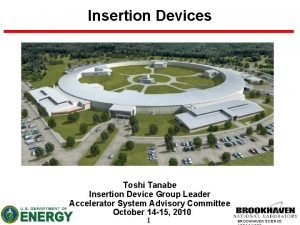LHC Luminosity Upgrades Using Insertion Modifications Peter Limon



































- Slides: 35

LHC Luminosity Upgrades Using Insertion Modifications Peter Limon April 18, 2007 P. Limon -- LARP Collaboration Meeting April 18, 2007 1

Outline • The options for luminosity upgrades using modified or additional insertion magnets – I am not talking about increases in beam current although some insertion modifications may allow beam current increases. – I will mostly talk about quadrupoles, because that is what I have worked on most. Many of the same issues concern close-in dipoles. • The challenges – For the experiments – For the collider & magnets • Some issues and possibilities • The next steps in R&D • Conclusions P. Limon -- LARP Collaboration Meeting April 18, 2007 2

Options • Reproduce the present optics with stronger, and/or larger-aperture triplets • Same as above with triplets moved closer to the interaction region • Additional quadrupoles in front of the existing, modified inner triplet • Any of these options can, by themselves, increase the luminosity by about a factor of 1. 5 to 2 • A close-in dipole might help reduce the crossing angle and provide a further increase of the luminosity. P. Limon -- LARP Collaboration Meeting April 18, 2007 3

Issues • There are two basic issues for the experiments – Displacement, interference with, or elimination of parts of the detectors – Scattering and albedo of particles into the detectors • There are three basic issues for the LHC – Developing and building magnets that reach the performance goals • Field strength & quality, aperture, radiation hardness, reliability. . . – Reducing or removing the heat deposited by the interaction debris – The effects on the parameters and performance of the LHC • There are two basic issues in common – A design that permits the detectors to open for service or modifications – Implementing stable mechanical support and cryogenic and electrical services for the magnets P. Limon -- LARP Collaboration Meeting April 18, 2007 4

Integrating with the Detectors (1) • ATLAS: – The forward calorimeter is close to the IP • In order to remove it for service, the beam tube has to be of constant diameter. The beam tube is the major source of background. • The toroid is specifically designed to be “open, ” so there is little shielding for the muon system. – Hence, there is dense shielding around the beam tube which can be replaced (sort of) by magnets. – Also, the solenoid is short and weak (2 T), so the fringe field is small. • Little interference with the quadrupoles (Q 0) or even the dipole D 0 P. Limon -- LARP Collaboration Meeting April 18, 2007 5

ATLAS P. Limon -- LARP Collaboration Meeting April 18, 2007 6

ATLAS Neutron Background Sources From V. Hedberg Effects of converting disk & endcap toroids to steel P. Limon -- LARP Collaboration Meeting April 18, 2007 7

Integrating with the Detectors (2) • CMS: – The forward calorimeter is far away ~ 12 m • Hence, there can be nothing in front of it. • The beam tube is tapered, so it is not an important source of background. • The return yoke shields most of the muon system, so the shielding around the beam tube is minimal. • The major source of background is the TAS, which is heavily shielded. – Putting in a D 0 or Q 0 will require major modifications to the CMS experiment. • The forward cal (if any, in the upgraded configuration) must be moved closer to the IP, in front of the magnets. – The CMS solenoid is long (6 m) and strong (4 T), so the fringe field is strong near the magnets, particularly D 0. – The magnet supports and services must permit opening the detector, he forward parts of which slide away from the IP. P. Limon -- LARP Collaboration Meeting April 18, 2007 8

CMS P. Limon -- LARP Collaboration Meeting April 18, 2007 9

Larger-Aperture Triplet • Advantages – Preserves present or similar optics – Larger aperture and/or stronger, allowing more shielding and smaller b* • The triplet is the determining aperture of the LHC. Smaller b* leads to larger bmax, which strains the collimation system. Larger aperture provides some relief. – If one uses Nb 3 Sn, the increased temperature margin will permit a significant increase in luminosity, > factor 3 – Preserves the decoupling of detector and LHC spaces • Disadvantages – Potentially fatal heating from debris. Must understand the debris effects • Requires the success of Nb 3 Sn magnet R&D for significant luminosity increase – Decrease in b* is factor of two, but increase in luminosity due to b* is less due to crossing-angle and waist effects. – Larger bmax, resulting in large chromaticity that may be difficult to compensate. Correction is by sextupoles in the arcs. • This effect is worse if magnets are weaker and longer (i. e. Nb. Ti). P. Limon -- LARP Collaboration Meeting April 18, 2007 10

Magnet Challenges (1) • The requirements for inner triplet quadrupoles that significantly increase luminosity appear feasible but not easy – Gradient requirement is not much greater than the present quads, but increased aperture makes the peak field high – Heating due to the interaction debris must be removed – Nb 3 Sn has greater temperature margin and higher field capability • R&D is progressing on Nb 3 Sn quadrupoles – In the U. S. DOE labs (LARP) – In Europe (CARE/NED) – In Japan (Nb 3 AL? ) P. Limon -- LARP Collaboration Meeting April 18, 2007 11

Nb 3 Sn or Nb. Ti? • Which technology should be used? • The answer is------It depends! • If the goal is to reach nominal or slightly more – Nb. Ti may be adequate, * but some increases might be possible without any magnet changes at all. It depends on what the limiting factors are. – * For example, E. Tedesco, et al. , Parametric studies for a phase-one LHC upgrade based on Nb-Ti, MCS Seminar, March 30, 2007. To be distributed? • If the goal is to increase luminosity by factor of 2 or more – Nb 3 Sn (or Nb 3 Al or HTS or Mg. B 2 -- a material with large temperature margin) will be necessary – The most important (but not the only) factor is heating from interaction debris P. Limon -- LARP Collaboration Meeting April 18, 2007 12

Beam Losses in Inner Triplet From N. Mokhov P. Limon -- LARP Collaboration Meeting April 18, 2007 13

Temperature Margin From A. Zlobin • Based on realistic construction models at 1 x 1034 – I. e. Potted Nb 3 Sn coils; st. st collars; iron yoke P. Limon -- LARP Collaboration Meeting April 18, 2007 14

Gaining Small Factors (1) • There a number of options that do not involve major modifications or new magnets – Increase the bunch spacing • This by itself would increase the luminosity at constant current • Decreases electron cloud and (maybe) long-range beam-beam effects – Decrease the collision angle • This may be possible if the current is low or if we go to fewer bunches. Limited by long-range beam-beam. – Remove the beam-tube liner in the inner triplet • This could be effective if physical aperture is a limit to b* • Fewer bunches moderate the electron cloud effects – There are surely others P. Limon -- LARP Collaboration Meeting April 18, 2007 15

Gaining Small Factors (2) • Can the efficiency for data-taking be increased? – The integrated luminosity per year is projected to be between 60 - 100 fb-1 – At a peak luminosity of 1 x 1034, 100 fb-1 /yr corresponds to ~1. 6 x 107 s/yr, which would be phenomenal performance • Fermilab, for example, regularly attains ≥ 1 x 107 s/yr of data taking, but not much more P. Limon -- LARP Collaboration Meeting April 18, 2007 16

Moving the Triplet Closer • An upgraded triplet, similar to the previous example, is moved closer to the IP – There is improvement for each meter that the triplet is closer. Studies have been done down to ~ 13 m from the IP. • Advantages – bmax is smaller, has less effect on chromaticity and aperture can be smaller, or, probably more important, collimators can be opened up (maybe). • Disadvantages – Potentially more heating from debris • Quads are long and strong, and therefore see lots of debris • Requires the success of Nb 3 Sn R&D – Impinges (somewhat) on the detectors – May require a “thin-quad” design depending on how close to the IP – Small-aperture TAS is also closer, generating more albedo; one may be able to redesign the TAS if the magnet aperture is larger – May require a new support structure for magnets and shielding P. Limon -- LARP Collaboration Meeting April 18, 2007 17

Pay More Attention to the Structure P. Limon -- LARP Collaboration Meeting April 18, 2007 18

Pay Attention to the Support Structure P. Limon -- LARP Collaboration Meeting April 18, 2007 19

Quads in Front of Triplet • A doublet (or singlet) is inserted between the triplet and the IP, starting about 12 m from the IP - “Q 0” • Advantages – bmax is smaller - magnet apertures of doublet & triplet may be smaller • Less effect on chromaticity – Less debris heating because quads are shorter and weaker - MAYBE • Disadvantages – – – Will require the success of the Nb 3 Sn R&D Impinges on the detectors Requires a “thin-quad” design. i. e. little or no steel Requires a TAS, a severe source of background for detectors. Requires a new support system for magnets and shielding P. Limon -- LARP Collaboration Meeting April 18, 2007 20

Quads in Front of Triplet P. Limon -- LARP Collaboration Meeting April 18, 2007 21

An Issue Concerning Q 0 Doublet • It is possible that the geometry of a Q 0 doublet may not match well to the LHC lattice. • A better match may be an outer doublet and an inner triplet. – A singlet between the IP and the triplet, and changing the triplet into a doublet. There are some promising results for this arrangement. • For integration purposes this does not matter, provided there is some quadrupole solution. – The issues for integration concern magnets, services, beam heating. These will be approximately the same in any solution. P. Limon -- LARP Collaboration Meeting April 18, 2007 22

ATLAS P. Limon -- LARP Collaboration Meeting April 18, 2007 23

Location of Forward Quads in ATLAS possible location of new quads P. Limon -- LARP Collaboration Meeting April 18, 2007 24

CMS P. Limon -- LARP Collaboration Meeting April 18, 2007 25

Magnet Challenges (2) • The biggest challenge is removing the heat caused by the beam debris. – Not only the total load, but the peak power deposition – Very close-in dipoles may be even more difficult. • There are other issues – The interaction of unshielded magnets with the solenoid field and the neighboring iron, particularly CMS. – Dense shielding coexisting with cryogenics and cryostat. • Close-in magnets are a major magnet challenge for the quadrupole plans considered, even if Nb 3 Sn R&D is successful P. Limon -- LARP Collaboration Meeting April 18, 2007 26

Energy Deposition Preliminary Power deposition (W) with staggered aperture TAS and 10 mm Cu liner TAS Q 01 Lnr Q 01 Q 02 lnr Q 02 1550 100 150 180 This is essentially the same as without a liner. P. Limon -- LARP Collaboration Meeting Lum = 1035 Power in m. W/cm 3 Courtesy of E. Wildner April 18, 2007 27

Advantage of Liner Preliminary So, why use a liner? Because it evens out the deposition. Power (m. W/cm 3) vs. unfolded angle & depth with 1 m TAS and 1 cm Cu liner at L=1035 Thanks to Elena Wildner P. Limon -- LARP Collaboration Meeting April 18, 2007 28

Some Other Issues • Lots of mechanical issues – Have to support the quads in the forward position. – Quads have to permit opening of the detector • I. e. Outer diameter less than ~ 45 - 50 cm – This seems possible, but there will be minimal iron to reduce fringe field and interaction with surrounding steel – Have to remove heat due to interaction debris – What about pipes & valves? Need details P. Limon -- LARP Collaboration Meeting April 18, 2007 29

Coaxial Cooling • Coaxial cooling design based on Tevatron • Tevatron quadrupole – ~100 T/m with old-style Nb. Ti. New Nb. Ti could reach 150 T/m – 77 mm coil aperture is more than adequate – Heat transfer and cooling must be redesigned – Outer diameter of cryostat is 20 cm P. Limon -- LARP Collaboration Meeting April 18, 2007 30

Coaxial Cooling for Q 0 • Coil aperture = 70 mm Thick Liner Collars – 10 mm liner – 45 mm physical aperture • Outer diameter=300 mm – 20 mm coil thickness – 20 mm collar thickness – 20 mm vacuum space including intermediate thermal shield – 40 mm low-pressure helium • Pressure-vessel cylinder – laminated from copper and stainless bimetallic sheets Heat Exchanger From G. Kirby P. Limon -- LARP Collaboration Meeting Pressure Vessel Thermal Shield April 18, 2007 31

Material for Special Pressure Vessel Tube P. Limon -- LARP Collaboration Meeting April 18, 2007 32

Close-in Dipole • Dipole begins as close as possible to IP ~ 3. 5 m – It is in a strong magnetic field, especially in CMS • Forces, torques, field disturbance, quench forces. . . • Even if the magnet can be supported, the ends may be crushed and need internal support. – Can it be made with a large aperture? • Yes. There appears to be room to make a 4 T - 6 T dipole with a 30 cm bore diameter (No outside iron) – What about the interaction debris? • It may not be so bad. Since it has large aperture, the cold mass is at low h (large angle), so flux is reduced. – What about albedo • Don’t know. Large aperture increases magnetic albedo but may permit a large-aperture TAS. P. Limon -- LARP Collaboration Meeting April 18, 2007 33

Next Steps in the R&D • A list of R&D topics – Continue & expand Nb 3 Sn magnet R&D • Model quads • Long quadrupoles – More Nb 3 Sn magnet R&D – Even more aggressive Nb 3 Sn magnet R&D – What else? • Much more work on energy deposition & cooling • Support structure, alignment techniques, etc. • Etc. – Lots of detector R&D -- shielding, backgrounds, services, access. . . P. Limon -- LARP Collaboration Meeting April 18, 2007 34

CONCLUSIONS • The magnets themselves are not impossible – However, they rely on the success of Nb 3 Sn R&D • The solution lies in optimizing a complex set of parameters – Useful luminosity, effect on the LHC performance and so forth. – Some of the problems are difficult. We need to define some boundaries. • We need to establish regular and useful lines of communication among, AT, AB, LARP and the experiments. We need to do this soon! • There is a need for more magnet R&D in more places P. Limon -- LARP Collaboration Meeting April 18, 2007 35
 Sketch map of paris basin
Sketch map of paris basin Limon congelado para el cancer
Limon congelado para el cancer Melanosis en limon
Melanosis en limon Fresas
Fresas Experimento tinta invisible con limon
Experimento tinta invisible con limon Densidad del limon
Densidad del limon Rima con choclo
Rima con choclo Aviation system block upgrades asbu
Aviation system block upgrades asbu Extranet mng
Extranet mng Opmet briefing
Opmet briefing Aviation system block upgrades
Aviation system block upgrades Aviation system block upgrades
Aviation system block upgrades Photo search
Photo search Modifications in roots
Modifications in roots Blackhawk modifications
Blackhawk modifications Modified crib clasp
Modified crib clasp Accommodations and modifications
Accommodations and modifications Les verbes introducteurs
Les verbes introducteurs Applegates classification
Applegates classification Accommodations vs modifications chart
Accommodations vs modifications chart Difference in accommodations and modifications
Difference in accommodations and modifications Difference in accommodations and modifications
Difference in accommodations and modifications Mizar luminosity
Mizar luminosity Luminosity vs flux
Luminosity vs flux At the center of the sun, fusion converts hydrogen into
At the center of the sun, fusion converts hydrogen into E 0
E 0 Luminosity class definition
Luminosity class definition Brightness vs luminosity
Brightness vs luminosity Luminosity distance
Luminosity distance Cobe
Cobe Luminosity
Luminosity Luminosity vs temperature
Luminosity vs temperature Luminosity
Luminosity Luminosity lpi
Luminosity lpi Bellettini
Bellettini Lhc louisiana
Lhc louisiana
